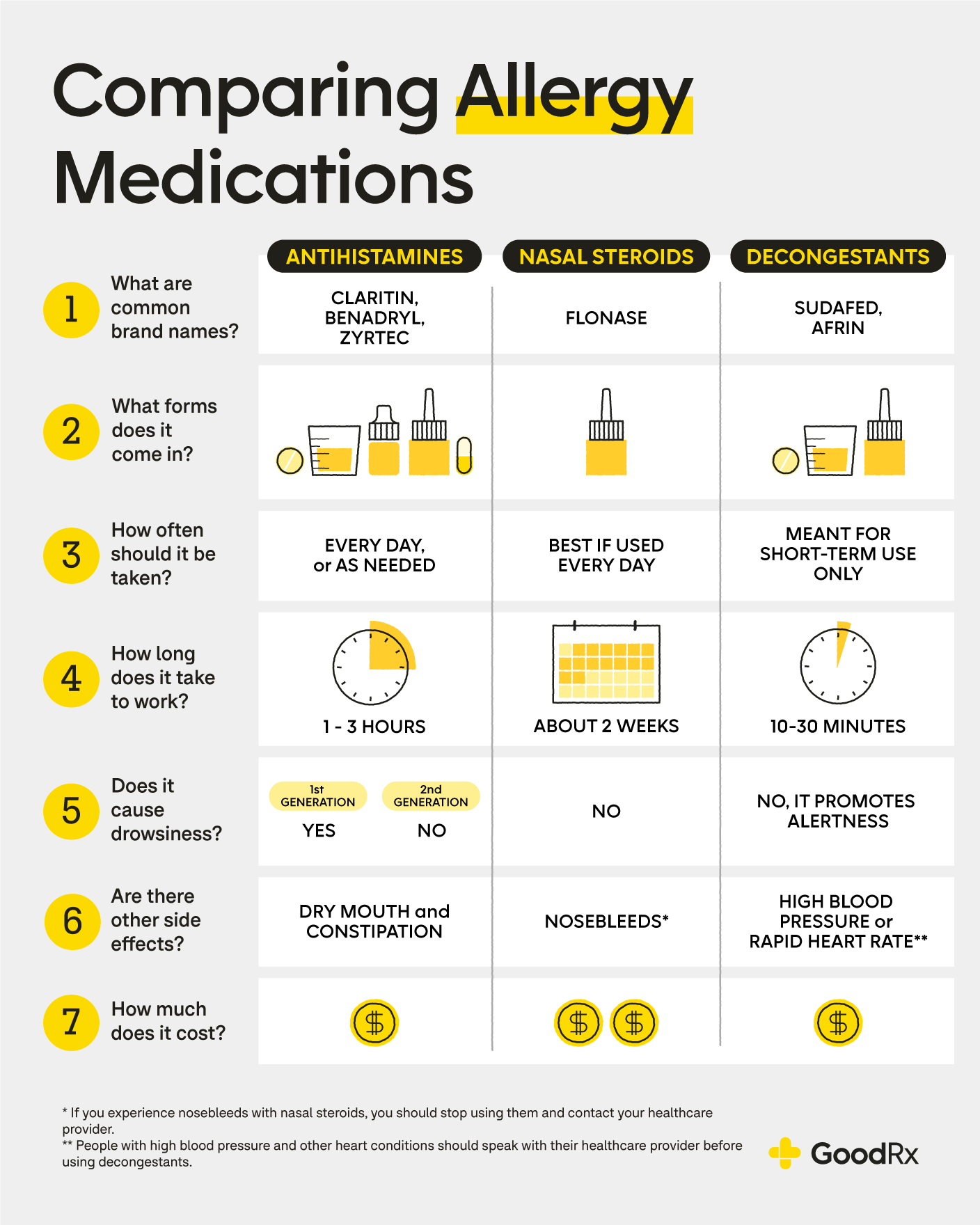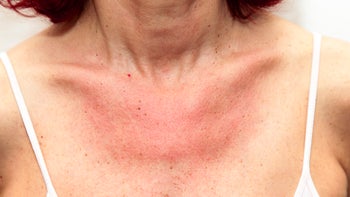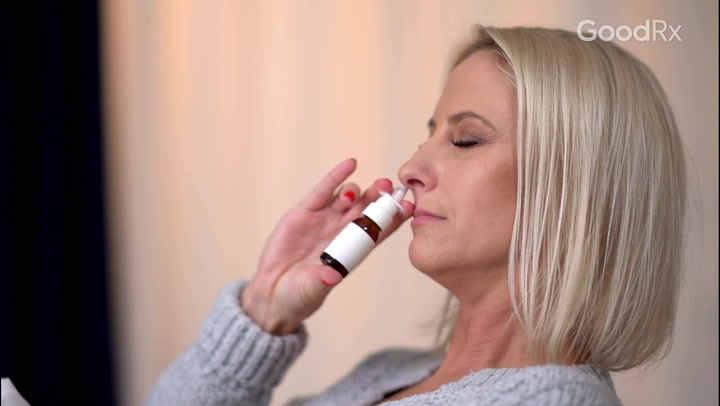
A Guide to the Best OTC Allergy Medicines
Key takeaways:
There are many different over-the-counter (OTC) allergy medications. Popular categories include antihistamines, decongestants, and corticosteroids. You can find them as oral liquids and pills, eye drops, and/or nasal sprays.
Some OTC allergy medications, like decongestants, are meant for short-term use. Antihistamines relieve symptoms fast. But like steroid nasal sprays, they control symptoms the best when they’re taken every day.
The best OTC allergy medication for you can depend on your symptoms, health history, and other factors. Your prescriber or pharmacist can help you navigate your options.
Access savings on related medications
Table of contents

If you’re struggling with allergy symptoms, help might be as close as your nearest pharmacy. Allergies are common, and many effective allergy medications are available over the counter (OTC). Antihistamines, decongestants, and steroid nasal sprays are a few options. And you can find them in many combination products, too.
Let’s take a closer look at the types of OTC allergy meds.
Antihistamines
Antihistamines work by blocking histamine, a chemical released from your cells during an allergic reaction. Blocking histamine can reduce symptoms like itchy eyes, sneezing, and a runny nose.
Stay healthy with CVS
Shop the brands you trust at CVS. Whether it’s wellness or beauty, get what you need at great prices.

Antihistamines are available OTC as oral liquids, capsules, and tablets. Eye drops and nasal sprays are also available. Oral antihistamines have more body-wide effects compared to those used in your eyes or nose. Some of them can make you feel drowsy, while others are considered non-drowsy.
Oral medications | Eye drops | Nasal sprays |
Non-drowsy: Drowsy: | • Ketotifen (Zaditor, Alaway) | • Azelastine (Astepro) |
*May still cause drowsiness in some people taking it
Pharmacist tip: If you’re taking oral antihistamines to manage your allergy symptoms, experts recommend taking them every day — not just when your symptoms flare up. And starting them a few weeks before allergy season hits can help prevent symptoms in the first place.
Read more about OTC antihistamines here:
Zyrtec vs. Claritin vs. Allegra: Which Works Best for Allergies?
Xyzal vs. Zyrtec: Side Effects, Differences & Other Allergy Meds
Is It Safe to Take Benadryl, Zyrtec, Claritin, and Allegra Together?
Comparing Pataday Eye Drops: Extra Strength (Pazeo), Once Daily (Pataday), and Twice Daily (Patanol)
Decongestants
Decongestants narrow blood vessels in the nasal passages, leading to decreased swelling. This temporarily relieves nasal congestion and sinus pressure. Certain decongestants are available behind the pharmacy counter, while others can be found in the OTC aisle.
Oral medications | Nasal spray |
• Pseudoephedrine (Sudafed)* | • Oxymetazoline (Afrin, Dristan) |
*Available behind the counter or with a prescription, depending on where you live
Pharmacist tip: Unlike antihistamines, decongestants are meant for short-term use. So, they can be helpful in a pinch. Oral decongestants shouldn’t be taken for longer than 7 days, unless directed by a healthcare professional. Nasal decongestants shouldn’t be used for longer than 3 days. Otherwise, your symptoms may become harder to treat.
Read more about OTC decongestants here:
Steroid nasal sprays
Steroid nasal sprays work by reducing swelling and inflammation inside your nasal passages and sinuses. This can help control sneezing and a runny nose. Compared to other OTC allergy medications, steroid nasal sprays tend to work the best for managing symptoms.
Examples of OTC steroid nasal sprays include:
Budesonide (Rhinocort Allergy)
Fluticasone (Flonase Allergy Relief, Flonase Sensimist)
Triamcinolone (Nasacort Allergy 24HR)
Mometasone (Nasonex 24HR Allergy)
Pharmacist tip: It can take up to 2 weeks to get the full benefit from steroid nasal sprays. If you’re already experiencing allergy symptoms, taking an antihistamine in the meantime can help bridge the gap until the nasal sprays start to work. Similar to antihistamines, it’s recommended to start a steroid nasal spray a few weeks before your allergies start to kick in.
Read more about OTC steroid nasal sprays here:
Combination antihistamine and decongestant medications
You can also find antihistamines and decongestants combined in one pill, as well as in an eye drop.
Since many oral combination products contain pseudoephedrine, they’re typically located behind the pharmacy counter. And similar to nasal decongestants, you should limit eye drop use to no more than 3 days. If you use them for longer, your symptoms may get worse.
Oral medications | Eye drops |
• Cetirizine / pseudoephedrine (Zyrtec-D) |
Pharmacist tip: Combination products can be a convenient option. But sometimes, you may end up taking additional ingredients that you don’t need. In other cases, you may accidentally double up on ingredients if you’re taking multiple products with the same ingredient. Check the active ingredients list on the OTC Drugs Facts label to be sure.
Mast cell stabilizers
Mast cell stabilizers work by acting on immune system cells responsible for triggering allergy symptoms. When taken preventatively, they can improve symptoms like swelling, sneezing, and runny nose. Currently, only one mast cell stabilizer nasal spray is available OTC — cromolyn (NasalCrom).
Pharmacist tip: Cromolyn nasal spray can take up to 4 weeks to work. So, it may not be the best choice if you need fast relief. And compared to other OTC nasal sprays for allergies, you need to use it more often — up to six times daily compared to once or twice a day. What’s more, they’re likely less effective than steroid nasal sprays.
What is the best OTC allergy medication?
In general, experts recommend steroid nasal sprays as first-choice medications for people with allergies. But they may not work for everyone. The best OTC allergy medicine for you can depend on your symptoms, health history, and other factors.
For example, certain allergy medicines may be preferred over others if you’re pregnant. Older adults should avoid antihistamines that cause drowsiness, such as diphenhydramine. And decongestants can have serious side effects if you have high blood pressure that’s uncontrolled.
You may also find that you get better relief when combining more than one type of OTC allergy medication, like an oral antihistamine with a steroid nasal spray. But you should avoid combining multiple allergy medicines from the same class.
The graphic below compares the three common types of allergy medications based on dosage forms, side effects, costs, and more.

Still have questions? Your prescriber and pharmacist can help. They can be great resources to help you pick a safe and effective OTC allergy medication.
Prescription allergy medicines and treatments to consider
In addition to OTC allergy medications, there are many prescription medications for allergies. If your OTC medication does not work, talk to your prescriber. It’s possible that a prescription medication would be better for you. Examples of these include:
Dymista (fluticasone / azelastine) nasal spray
Ryaltris (olopatadine / mometasone) nasal spray
Patanase (olopatadine) nasal spray
Singulair (montelukast) tablets
Your healthcare team can also talk to you about other treatments. For example, allergy shots and a shot-free alternative called SLIT (sublingual immunotherapy) can help decrease allergic reactions in some people.
The bottom line
There are many over-the-counter (OTC) allergy meds to choose from. They come as oral pills and liquids, eye drops, and nasal sprays. Antihistamines and steroid nasal sprays are popular options. But you may also find relief from decongestants and mast cell stabilizers.
The best OTC allergy medication for you depends on your symptoms, health history, and preferences. Discuss your options with your prescriber or pharmacist to help you find one that meets your needs and provides relief.
Why trust our experts?


References
Alcon Laboratories, Inc. (2024). Naphcon A - naphazoline hydrochloride and pheniramine maleate solution/ drops [package insert]. DailyMed.
Bausch and Lomb Incorporated. (2023). Opcon-A - naphazoline hydrochloride and pheniramine maleate solution/ drops [package insert]. DailyMed.
B.F. Ascher and Co, Inc. (2023). Neo-synephrine regular - phenylephrine hydrochloride spray [package insert]. DailyMed.
Dykewicz, M. S., et al. (2020). Rhinitis 2020: A practice parameter update. The Journal of Allergy and Clinical Immunology.
Johnson and Johnson Consumer Inc. (2024). Visine allergy eye relief multi-action- naphazoline hydrochloride and pheniramine maleate solution/ drops package insert]. DailyMed.
MedlinePlus. (2017). Cromolyn sodium nasal solution.
Seidman, M. D., et al. (2015). Clinical practice guideline: Allergic rhinitis. Otolaryngology–Head and Neck Surgery.

























